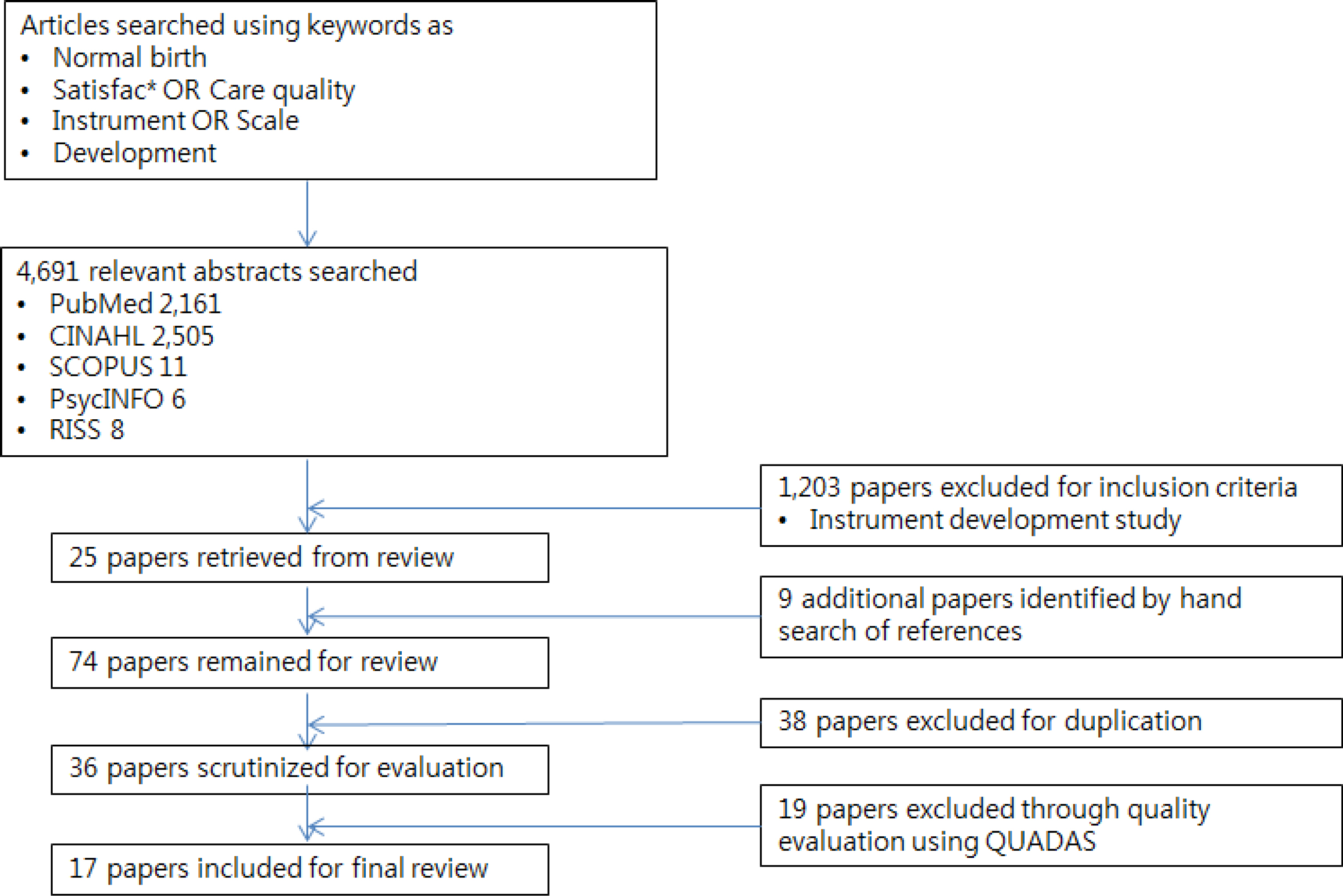Korean J Women Health Nurs.
2017 Dec;23(4):221-232. 10.4069/kjwhn.2017.23.4.221.
A Systematic Review of Birth Experience Assessment Instrument
- Affiliations
-
- 1Department of Nursing, KC University, Seoul, Korea. leomommy@hanmail.net
- KMID: 2424157
- DOI: http://doi.org/10.4069/kjwhn.2017.23.4.221
Abstract
- PURPOSE
This study aimed to conduct a systematic review and to describe characteristics of the birth experience assessment instrument.
METHODS
Literature related to the development of the birth experience assessment instrument was examined using a systematic review method. A literature search was conducted using the keywords as "˜[normal birth]; [satisfac* OR care quality]; [instrument OR scale] AND (development)' through PubMed, CINAHL, SCOPUS, PsycINFO, and RISS. The search used quality appraisal through QUADAS (Quality Assessment of studies of Diagnostic Accuracy included Systemic reviews) yielding 17 records.
RESULTS
The birth experience assessment instrument was categorized for instrumental characteristics: birth satisfaction (n=8), perception of labor experience (n=5), and birth care quality assessment in normal and operative birth experiences (n=4). Important key elements for content characteristics were as follows: nursing practice (n=10), pain control (n=5), environment (n=5), participation (n=4), and support (n=4).
CONCLUSION
This study demonstrated that the birth experience instrument is appropriate for measuring quality of birth care in various clinical conditions. This review of the birth experience instrument reports that an appropriate psychometric tool for enhancing quality of birth care is important.
Keyword
MeSH Terms
Figure
Reference
-
References
1. Statistics Korea. 2017 population statistics [Internet]. Seoul: Korean Statistical Information Service;2017. [cited 2017 March 2]. Available from:. http://kosis.kr/statisticsList/statisticsL-ist_01List.jsp?vwcd=MT_ZTITLE&parentId=A.2. Janssen PA, Dennis CL, Reime B. Development and psychometric testing of the care in obstetrics: Measure for testing satisfaction (COMFORTS) scale. Research in Nursing and Health. 2006; 29(1):51–60.
Article3. Sandin-Bojö AK, Larsson BW, Hall-Lord ML. Women's perception of intrapartal care in relation to WHO recommendations. Journal of Clinical Nursing. 2008; 17(22):2993–3003.
Article4. Martin CH, Fleming V. The birth satisfaction scale. International Journal of Health Care Quality Assurance. 2011; 24(2):124–135.5. Ford E, Ayers S, Wright DB. Measurement of maternal perceptions of support and control in birth (SCBI). Journal of Women's Health. 2009; 18(2):245–252.6. Mohammad K, Shaban I, Homer C, Creedy D. Women's satisfaction with hospital-based intrapartum care: A Jordanian study. International Journal of Nursing and Midwifery. 2014; 6(3):32–39.7. Smith LF. Development of a multidimensional labour satisfaction questionnaire: Dimensions, validity, and internal reliability. Quality in Health Care. 2001; 10(1):17–22.
Article8. Harvey S, Rach D, Stainton MC, Jarrell J, Brant R. Evaluation of satisfaction with midwifery care. Midwifery. 2002; 18(4):260–267.
Article9. Hodnett ED. Pain and women's satisfaction with the experience of childbirth: A systemic review. American Journal of Obstetrics and Gynecology. 2002; 186(5):160–172.10. Denker A, Taft C, Bergqvist L, Lilja H, Berg M. Childbirth experience questionnaire (CEQ): Development and evaluation of a multidimensional instrument. BMC Pregnancy and Childbirth. 2010; 10:81.
Article11. Uludag E, Mete S. Development and testing of women's perception for the scale of supportive care given during labor. Pain Management Nursing. 2015; 16(5):751–758.12. Kim SY, Park JE, Seo HJ, Lee YJ, Jang BH, Son HJ, et al. NECA's guidance for undertaking systematic reviews and metaanalysis for intervention. Seoul: National Evidence-based Healthcare Collaborating Agency;2011. p. 271. p.13. Whiting P, Rutjes AW, Reitsma JB, Bossuyt PM, Kleijnen J. The development of QUADAS: A tool for the quality assessment of studies of diagnostic accuracy included in systematic reviews. BMC Medical Research of Methodology. 2003; 3(25):1–13.
Article14. Whiting PF, Rutjes AW, Westwood ME, Mallett S, Deeks JJ, Reitsma JB, et al. QUADAS-2: A revised tool for the quality assessment of diagnostic accuracy studies. Annals of Internal Medicine. 2011; 155(8):529–536.
Article15. Fleiss JL. Statistical methods for rates and proportions. New York, NY: Wiley, John and Sons;2003. p. 336. p.16. Redshaw M, Martin CR. Validation of a perceptions of care adjective checklist. Journal of Evaluation in Clinical Practice. 2009; 15(2):281–288.
Article17. Sandin Bojö AK, Hall-Lord ML, Axelsson O, Udén G, Wilde Larsson B. Midwifery care: Development of an instrument to measure quality based on the World Health Organization's classification of care in normal birth. Journal of Clinical Nursing. 2004; 13(1):75–83.18. Cavalho EMP, Gottems LBD, Pires MRGM. Adherence to best care practices in normal birth: Construction and validation of an instrument. Journal of School of Nursing. 2015; 49(6):889–897.19. Fleming SE, Donovan-Batson C, Burduli E, Barbosa-Leiker C, Hollins Martin CJ, Martin CR. Birth Satisfaction Scale/Birth Satisfaction Scale-Revised (BSS/BSS-R): A large scale United States planned home birth and birth center survey. Midwifery. 2016; 41:9–15.20. Hollins Martin CJ, Martin CR. Development and psychometric properties of the Birth Satisfaction Scale-Revised (BSS-R). Midwifery. 2014; 30(6):610–619.
Article21. World Health Organization. Maternal and Newborn Health/Safe Motherhood Unit. Care in normal birth: A practical guide. Geneva: WHO;1996. p. 53. p.22. Simbar M, Ghafari F, Zahrani ST, Majd HA. Assessment of quality of midwifery care in labour and delivery wards of selected Kordestan Medical Science University hospital. International Journal of Health Care Quality Assurance. 2009; 22(3):266–277.23. Gungor I, Beji NK. Development and psychometric testing of the scales for measuring maternal satisfaction in normal and cesarean birth. Midwifery. 2012; 28(3):348–357.24. Lavender T, Wallymahmed AH, Walkinshaw SA. Managing labor using partograms with different action lines: A prospective study of women's view. Birth. 1999; 26(2):89–96.25. Park KH, Lee SH, Jin BK, Won JS. The effects of labor support behavior (LBS) one-to-one application and partner's delivery participation on the delivery satisfaction and delivery results among mothers who delivered premature birth and low weight infant. Journal of Korean Clinical Nursing Research. 2011; 17(2):239–250.
- Full Text Links
- Actions
-
Cited
- CITED
-
- Close
- Share
- Similar articles
-
- A Systematic Review of Child Abuse Screening Instruments
- Birth cohort effects on maternal and child environmental health: a systematic review
- Systematic review for new health technology assessment
- Patient Satisfaction in Spine Surgery: A Systematic Review of the Literature
- Posttraumatic Growth Measures in Breast Cancer Survivors: A Systematic Review


